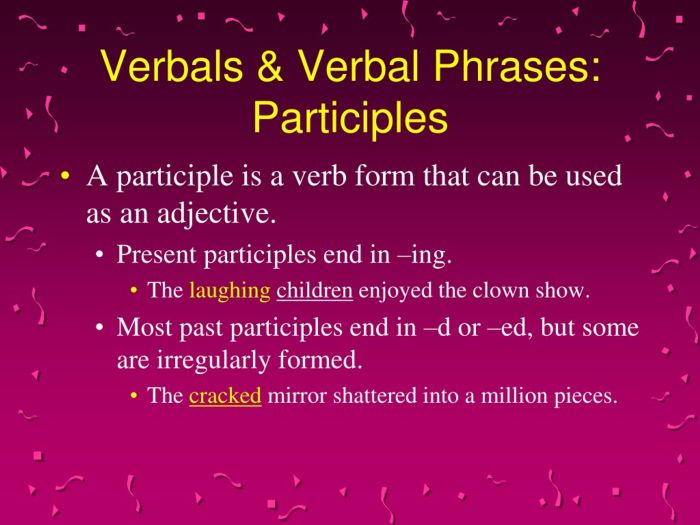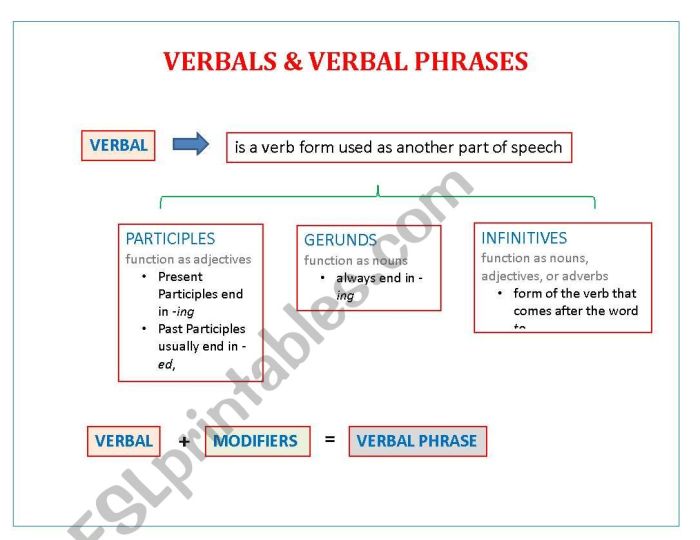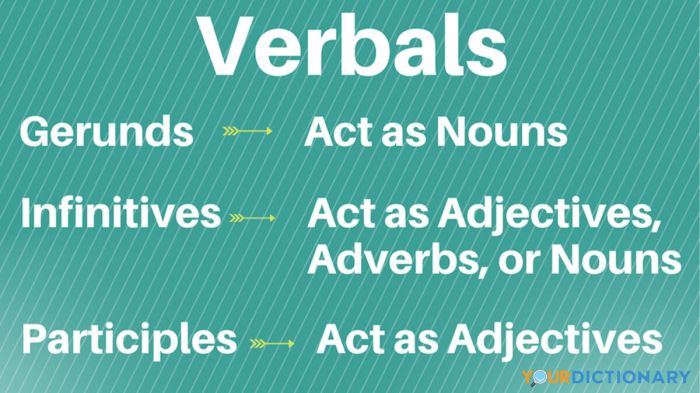Verbals and verbal phrases practice provides a comprehensive exploration of these essential grammatical concepts, equipping learners with a deep understanding of their functions, types, and applications.
This guide delves into the intricacies of verbals (gerunds, infinitives, and participles) and verbal phrases, examining their structure, functions, and usage in various contexts.
Definition of Verbals and Verbal Phrases

Verbals are words that are derived from verbs but function as other parts of speech, such as nouns, adjectives, or adverbs. There are three types of verbals: gerunds, infinitives, and participles.
Gerundsare verbals that end in -ing and function as nouns. They can be used as subjects, objects, or complements.
- Example: Running is my favorite exercise.
Infinitivesare verbals that are formed by adding “to” before the base form of a verb. They can function as nouns, adjectives, or adverbs.
- Example: I want to go to the store.
Participlesare verbals that end in -ing, -ed, or -en and function as adjectives. They can be used to describe nouns or pronouns.
- Example: The running child was out of breath.
Verbal phrases are groups of words that contain a verbal and any modifiers or objects. They can function as nouns, adjectives, or adverbs.
- Example: The running child was out of breath.(verbal phrase functioning as an adjective)
- Example: I want to go to the store.(verbal phrase functioning as a noun)
- Example: He ran quickly.(verbal phrase functioning as an adverb)
Types of Verbals and Verbal Phrases

Verbals are words that function as both verbs and other parts of speech. They can be used to express actions, states of being, or ideas. Verbal phrases are groups of words that include a verbal and any modifiers or objects.
There are three types of verbals: gerunds, infinitives, and participles. Each type of verbal can form different types of verbal phrases.
Gerunds
Gerunds are verbals that end in -ing. They function as nouns and can be used as subjects, objects, or complements.
- Subject: Runningis good exercise.
- Object:I enjoy running.
- Complement:My favorite hobby is running.
Infinitives
Infinitives are verbals that are formed by adding the word “to” before the base form of the verb. They function as nouns, adjectives, or adverbs.
- Noun:I want to run.
- Adjective:I am eager to run.
- Adverb:I ran to catchthe bus.
Participles
Participles are verbals that end in -ing (present participle) or -ed (past participle). They function as adjectives and can be used to describe nouns or pronouns.
- Present participle:The runningman won the race.
- Past participle:The tiredrunner collapsed.
Functions of Verbals and Verbal Phrases
Verbals and verbal phrases play diverse roles within sentences, functioning as nouns, adjectives, or adverbs.
Verbals as Nouns
Verbals can act as nouns, performing the same functions as common nouns, such as:
- Subject:The runningwas exhausting.
- Direct object:I enjoy writing.
- Indirect object:Give the paintingto me.
- Object of a preposition:He spoke about winning.
Verbal Phrases as Noun Phrases
Verbal phrases, consisting of a verbal and its modifiers, function as noun phrases, fulfilling the roles of:
- Subject: Running every dayis beneficial.
- Direct object:I prefer writing short stories.
- Indirect object:Show me the painting of the sunset.
- Object of a preposition:I am tired from working all day.
Verbals as Adjectives
Verbals can modify nouns like adjectives, describing or limiting their meaning:
- Present participle:The laughingchild
- Past participle:The brokenwindow
- Infinitive:The to-be-readbook
Verbal Phrases as Adjective Phrases
Verbal phrases can also act as adjective phrases, providing more detailed descriptions of nouns:
- Present participle phrase:The child laughing with joy
- Past participle phrase:The window broken by the storm
- Infinitive phrase:The book ready to be read
Verbals as Adverbs
Verbals can function as adverbs, modifying verbs, adjectives, or other adverbs:
- Present participle:He walked smiling.
- Past participle:He sat exhausted.
- Infinitive:He went to study.
Verbal Phrases as Adverb Phrases, Verbals and verbal phrases practice
Verbal phrases can also serve as adverb phrases, providing additional information about the manner, time, or place of an action:
- Present participle phrase:He walked with a smile on his face.
- Past participle phrase:He sat after finishing his work.
- Infinitive phrase:He went in order to learn.
Examples of Verbals and Verbal Phrases

Verbals and verbal phrases are versatile grammatical constructions that add depth and variety to writing. Let’s explore some examples to illustrate their usage and functions.
Gerunds
Gerunds are verbals ending in “-ing” that function as nouns. They can represent actions, states of being, or events.
- Example:Swimming is my favorite exercise.
- Example:The team’s cheering was deafening.
Infinitives
Infinitives are verbals that consist of the word “to” followed by the base form of a verb. They can function as nouns, adjectives, or adverbs.
- Example:I want to travel the world.
- Example:The book is ready to read.
Participles
Participles are verbals that end in “-ing” (present participle) or “-ed” (past participle). They can function as adjectives or adverbs, modifying nouns or verbs.
- Example:The running child passed by.
- Example:The broken window was replaced.
Verbal Phrases
Verbal phrases consist of a verbal and its modifiers or complements. They can function as different parts of speech, depending on the type of verbal they contain.
| Type of Verbal Phrase | Function | Example |
|---|---|---|
| Gerund Phrase | Noun | Swimming in the pool was refreshing. |
| Infinitive Phrase | Noun | To err is human. |
| Participle Phrase | Adjective | The man running down the street is my friend. |
| Participle Phrase | Adverb | Looking around, I realized I was lost. |
Practice Exercises

To enhance students’ comprehension of verbals and verbal phrases, it is essential to incorporate practice exercises into the learning process. These exercises serve as a valuable tool for students to apply their knowledge, identify verbals and verbal phrases within sentences, and understand their functions.
Practice exercises can be designed to test students’ understanding at various levels. Some exercises may focus on simply identifying verbals and verbal phrases within sentences, while others may delve deeper into their functions and usage.
Exercises for Identifying Verbals and Verbal Phrases
These exercises can help students develop their ability to recognize verbals and verbal phrases in different contexts.
- Provide students with sentences that contain verbals or verbal phrases. Ask them to identify the verbals or verbal phrases and classify them as gerunds, infinitives, or participles.
- Give students a list of words and ask them to identify which words can function as verbals.
- Present students with sentences that have missing verbals or verbal phrases. Ask them to complete the sentences by inserting appropriate verbals or verbal phrases.
Exercises for Understanding the Functions of Verbals and Verbal Phrases
These exercises aim to test students’ comprehension of the various functions that verbals and verbal phrases can serve in sentences.
- Provide students with sentences that contain verbals or verbal phrases. Ask them to identify the function of the verbal or verbal phrase (e.g., subject, direct object, modifier).
- Give students a list of sentences and ask them to rewrite each sentence using a verbal or verbal phrase to replace a clause or phrase.
- Present students with paragraphs that contain verbals or verbal phrases. Ask them to analyze the role of the verbals or verbal phrases in enhancing the meaning and flow of the text.
By engaging in these practice exercises, students can strengthen their understanding of verbals and verbal phrases, enabling them to use them effectively in their own writing and communication.
Query Resolution: Verbals And Verbal Phrases Practice
What are verbals?
Verbals are verb forms that function as nouns, adjectives, or adverbs without acting as the main verb of a sentence.
What are the three types of verbals?
The three types of verbals are gerunds (verbals ending in -ing that function as nouns), infinitives (verbals preceded by ‘to’ that function as nouns or adjectives), and participles (verbals that function as adjectives).
How are verbal phrases used in sentences?
Verbal phrases can function as noun phrases, adjective phrases, or adverb phrases, depending on the type of verbal they contain.